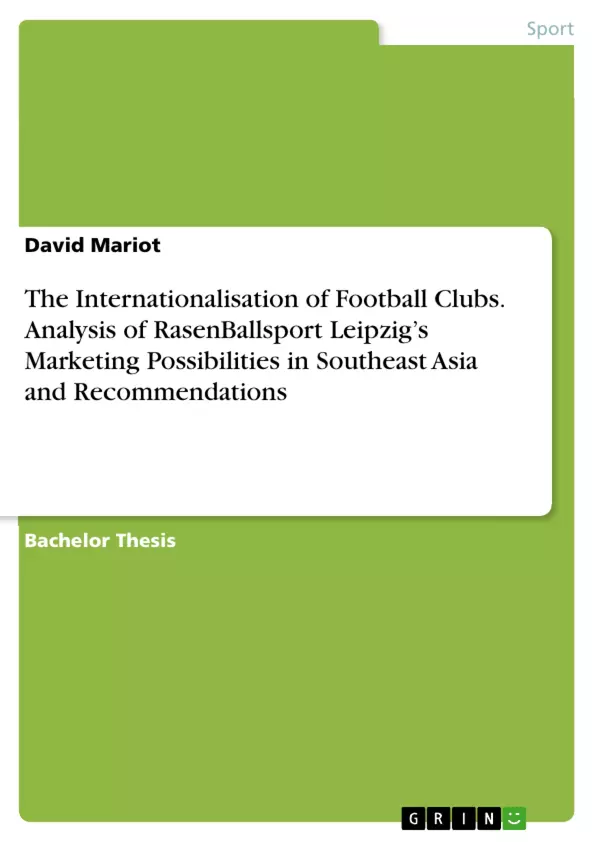The competition between professional football clubs is increasing both on a national as well as on an international level. Clubs do not only experience pressure for sporting success but also for economic profitability. As sporting success can hardly be planned, the club’s financial well-being needs to be ensured independently from results on the pitch.
The rationale seems obvious, a club’s higher popularity among fans leads to higher revenues. Football is the most popular sport in the world and almost half of the world’s population is interested in the sport. With this in mind, it seems naive or even negligent that the majority of professional German football clubs keep on serving the national market only. Sounding like a repeated appeal, Karl-Heinz Rummenigge, CEO of the most internationalised German football club FC Bayern Munich, describes internationalisation as “without any alternative“. He continues by explaining “without growth on the international markets, you risk the sporting competitiveness“.
With a population of over 600 Million people and a high enthusiasm for football, Southeast Asia invites football clubs to start their internationalisation in the region. Hence only a structured approach and a thoughtful strategy are required to finally and successfully enter these promising markets.
Inhaltsverzeichnis (Table of Contents)
- Introduction
- Objective of the Thesis
- Structure of the Thesis
- Interview Partners
- Theoretical framework
- Definition and differentiation of the term Internationalisation
- Internationalisation‟s Relevance
- Market Entry Strategies
- Online presence
- Exporting
- International Licensing
- International Franchising
- Strategic Alliances
- Joint Ventures
- Acquisition
- Greenfield Investment
- Influencing Factors
- Internal Factors
- External Factors
- Status Quo of Internationalisation in German Football
- The role of the “DFL Deutsche Fußball Liga GmbH”
- Comparison of Bundesliga teams‟ Internationalisation processes
- German football in international comparison
- The choice of RasenBallsport Leipzig as example for this thesis
- RasenBallsport Leipzig‟s Internationalisation Process
- Methodology
- SWOT Analysis of RB Leipzig
- Strengths
- Weaknesses
- Opportunities
- Threats
- RasenBallsport Leipzig‟s market entry options
- Timing
- Possible market entry strategies
- Merchandising
- Digitalisation
- Events
- Players
- Alliances and Partnerships
- Complementary measures
- Market choice
- Evaluation of the chosen Southeast Asian target markets
- Introduction to the target markets Indonesia, Malaysia, Singapore and Thailand
- Indonesia
- Malaysia
- Singapore
- Thailand
- Critical factors for Success
- Sports-related Factors
- Non-sports-related Factors
- Scoring Model of the pre-selected Markets
- Implications and recommended Internationalisation Modules
- Conclusion, Limitations and Outlook
Zielsetzung und Themenschwerpunkte (Objectives and Key Themes)
The thesis aims to provide a structured approach to planning and implementing international engagements for football clubs seeking new business opportunities in Southeast Asia. The work explores the market entrance possibilities, assesses potential target markets, and analyzes the feasibility of different internationalization strategies. The methodology and results are intended to be applicable by any professional football club with minimal adaptation.
- Internationalization of Football Clubs
- Market Entry Strategies
- Southeast Asian Market Analysis
- RasenBallsport Leipzig Case Study
- Internationalization Modules
Zusammenfassung der Kapitel (Chapter Summaries)
The first chapter introduces the concept of internationalization in professional football clubs, highlighting the increasing pressure for both sporting success and economic profitability. The chapter then delves into the specific challenges and opportunities of entering new markets, particularly Southeast Asia.
Chapter two provides a theoretical framework, defining internationalization and its relevance in the context of football clubs. It explores various market entry strategies, including online presence, exporting, licensing, franchising, strategic alliances, joint ventures, acquisition, and Greenfield investment. The chapter also analyzes the internal and external factors influencing the choice of an entry strategy.
Chapter three examines the current state of internationalization in German football, focusing on the role of the DFL Deutsche Fußball Liga GmbH and the individual efforts of Bundesliga teams. It compares the internationalization process of German clubs with those of other countries, notably the English Premier League, and concludes with the selection of RasenBallsport Leipzig as a case study.
Chapter four provides an in-depth analysis of RasenBallsport Leipzig's internationalization process, utilizing a SWOT analysis to evaluate its strengths, weaknesses, opportunities, and threats. The chapter then explores the club's market entry options, considering timing, possible strategies, and target market selection.
Chapter five focuses on the evaluation of four potential Southeast Asian target markets: Indonesia, Malaysia, Singapore, and Thailand. It introduces each market, highlighting its geographic, demographic, political, economic, and football-related characteristics. The chapter then assesses each market based on a scoring model that considers both sports-related and non-sports-related factors.
Schlüsselwörter (Keywords)
The main keywords and focus topics of the text include internationalization, football clubs, market entry strategies, Southeast Asia, RasenBallsport Leipzig, SWOT analysis, target market selection, sports-related factors, non-sports-related factors, scoring model, internationalization modules, and strategic recommendations.
- Citar trabajo
- David Mariot (Autor), 2017, The Internationalisation of Football Clubs. Analysis of RasenBallsport Leipzig’s Marketing Possibilities in Southeast Asia and Recommendations, Múnich, GRIN Verlag, https://www.grin.com/document/497950



